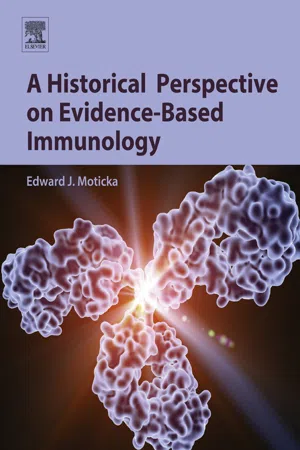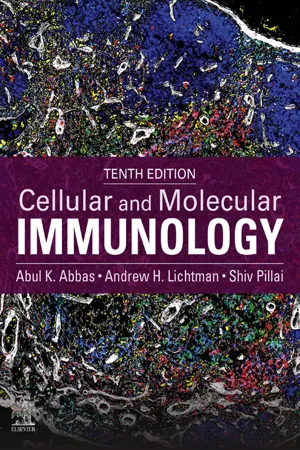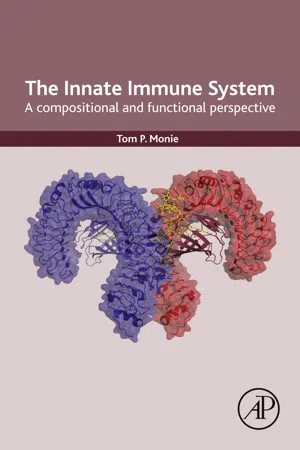Biological Sciences
Pattern Recognition Receptors
Pattern recognition receptors (PRRs) are a crucial component of the innate immune system, responsible for detecting and responding to various pathogens and danger signals. They recognize specific molecular patterns, such as those found on the surface of bacteria, viruses, and fungi, and initiate immune responses to combat these threats. PRRs play a fundamental role in the body's defense against infections and maintaining homeostasis.
Written by Perlego with AI-assistance
Related key terms
Related key terms
1 of 4
Related key terms
1 of 3
11 Key excerpts on "Pattern Recognition Receptors"
- eBook - ePub
- Dhia Bouktila, Yosra Habachi(Authors)
- 2021(Publication Date)
- Bentham Science Publishers(Publisher)
paradigm change in the plant defense field and instigated the recognition of PTI as a critically important component of the plant defense machinery. Since then, several new PRR candidate genes have been identified.1. PATTERN-RECOGNITION RECEPTORS (PRRs)
1.1. An Overview: Nature of PAMPs and Biochemical Structure of PRRs
Pathogen-associated molecular pattern (PAMP)-triggered immunity (PTI) to microbial infection constitutes an evolutionarily ancient type of immunity that is characteristic of all multicellular eukaryotic living things. Microbial patterns (PAMPs) activating plant PTI have been conserved through evolution ; in other words, these are molecules present in microorganisms, and which are slowly evolving due to the critical functions they exert for survival. These molecules, which are detected by PRRs, are diverse: bacterial (flagellin, elongation factor EF-Tu, and peptidoglycan) (), fungal (chitin, xylanase) (Gust et al. 2007), oomycete (β-glucan and elicitins) (Kaku et al. 2006), viral (double stranded RNA) (Du et al. 2015), and insect (aphid-derived elicitors) (Niehl et al. 2016).Prince et al. 2014Plant Pattern-Recognition Receptors (PRRs) mediate microbial pattern sensing and subsequent immune activation. PRRs include a range of non-specific receptors. These receptors often possess leucine-rich repeats (LRRs) that bind to extracellular ligands, transmembrane domains necessary for their localization in the plasma membrane, and cytoplasmic kinase domains for signal transduction through phosphorylation (Zipfel 2014 ). LRRs are highly divergent, associated with their ability to bind to diverse elicitors. Numerous PRRs rely on the regulatory protein brassinosteroid insensitive 1-associated receptor kinase 1 (BAK1) and other somatic embryogenesis receptor-like kinases (SERKs) ()2 .Prince et al. 20141.2. Best Known Examples of Bacterial and Fungal PAMPs and their Cognate Pattern Recognition Receptors
The LRR-RLKs FLS2, EFR and Xa21 are capable of detecting bacterial peptides such as flg22 from flagellin, elf18 from EF-Tu and AxYs22 from Ax21, respectively (;Kaku et al. 2006Gust et al - Edward J. Moticka(Author)
- 2015(Publication Date)
- Elsevier(Publisher)
PRRs bind ligands on microbes known as pathogen-associated molecular patterns (PAMPs). The binding of PRRs by PAMPs results in the engulfment of the microbe, upregulation of genes coding for inflammatory cytokines and costimulatory molecules, and processing of pathogen-specific peptides for presentation to antigen-specific T cells to activate the adaptive immune response. As such, PRRs serve an essential function in the activation of both innate host defenses and adaptive immune responses.Keywords
Danger-associated molecular patterns (DAMPs); Endotoxin; Exotoxin; Innate host defenses; Lipopolysaccharide; Opsonin; Opsonizaton; Pathogen-associated molecular patterns (PAMPs); Pattern Recognition Receptors (PRRs); Superantigen; TNF-α; Toll-like receptorsKeynames
Beutler, B.; Glode, M.; Heppner, G.; Hoffmann, J.; Janeway, C.; Medzhitov, R.; Metchnikov, I.; Nüsselin-Volhard, C.; Pfeiffer, R.; Riblet, R.; Tobias, P.; Watson, J.; Weiss, D.; Wright, A.; Wright, S.OutlineIntroduction 121Early Investigations on Recognition by Phagocytic Cells 122Molecules that Enhance Phagocytosis– Opsonization 122Recognition Based on Physical Characteristics 123Molecules that Enhance Phagocytosis: The Role of Lectins 123Discovery of Pattern Recognition Receptors 123Response to Bacterial Toxins 124Genetics of Fruit Fly Host Defense Mechanisms 124Discovery of the Receptor for Endotoxin (LPS) 125Conclusion 126References 127Time Line 128Introduction
Differentiation of self from foreign invaders is a hallmark of both innate host defense mechanisms and the adaptive immune response. Lymphocytes responsible for the adaptive immune response possess cell surface receptors specific for single antigens. The structure and genetic basis of these molecules are covered in Chapter 17- eBook - ePub
- Ian R. Tizard(Author)
- 2017(Publication Date)
- Saunders(Publisher)
2Innate Immunity
How to Detect Invaders
Chapter OutlineHow Invaders Are Recognized,9Pattern-Recognition Receptors, 10Toll-Like Receptors, 10RIG-1-Like Receptors, 13NOD-Like Receptors, 13Pathogen-Associated Molecular Patterns,14Bacterial Lipopolysaccharides, 14Bacterial Peptidoglycans, 14Bacterial DNA, 14Viral Nucleic Acids, 15Damage-Associated Molecular Patterns,15Soluble Pattern-Recognition Receptors,16Sentinel Cells,17Macrophages, 17Dendritic Cells, 17Mast Cells, 17Learning ObjectivesAfter reading this chapter, you should be able to:• Understand how the body detects both invading microbes and tissue damage by using specific receptors that bind conserved microbial molecules (PAMPs) as well as molecules released by broken cells (DAMPs).• Understand how PAMPs and DAMPs bind to pattern-recognition receptors (PRRs) found on cell surfaces or inside cells. • Understand how microbial nucleic acids can be detected by innate receptors. • Describe how other triggering signals come from damaged tissues or broken cells. • Understand that the most important family of PRRs consists of the toll-like receptors (TLRs). • Recognize the significance of lipopolysaccharides and other conserved microbial molecules in triggering innate immune responses. • List four major populations of sentinel cells. • List some microbial molecules that trigger responses by toll-like receptors. • Define Pattern Recognition Receptors; damage-associated molecular patterns; pathogen-associated molecular patterns; caspases; lectins; selectins.Bacteria and viruses multiply very rapidly. A single bacterium with a doubling time of 50 minutes can produce about 500 million offspring within 24 hours. When these microbes invade the body they must be destroyed before they can overwhelm its defenses. Time is of the essence, and delay can be fatal. The body must therefore employ fast-acting response mechanisms as its first line of defense against invaders. These mechanisms need to be on constant standby and respond to the first signs of microbial invasion. They constitute the innate immune system. - eBook - ePub
Immunology
A Short Course
- Richard Coico(Author)
- 2021(Publication Date)
- Wiley-Blackwell(Publisher)
Most microorganisms encountered daily in the life of a healthy individual are detected and destroyed within minutes to hours by innate defense mechanisms. Mechanistically, innate immunity is carried out by nonspecific physical and chemical barriers (e.g., the skin, acid pH or the stomach), cellular barriers (e.g., phagocytes), and molecular pattern‐based reactions. This section describes the latter mechanism, which is used by a phylogenetically diverse set of species (fish, fruit flies, mammals) to enable host defense systems to detect the presence of foreign antigens that may do harm: the Pattern Recognition Receptors. Based on their molecular structure, PRRs can be divided into multiple families, including TLRs, C‐type lectin receptors, NOD‐like receptors, and RIG‐I‐like receptors.Toll‐Like Receptors.
A major class of Pattern Recognition Receptors is the TLRs. The Toll gene family was originally discovered via its contribution to dorsoventral patterning in Drosophila melanogaster embryos. Later, studies showed that Toll genes encode proteins that play a critical role in the fly’s innate immune response to microbial infection. Further investigation then confirmed the existence of homologous proteins in mammals (TLRs) that can activate phagocytes and DCs to respond to pathogens. TLRs make up a large family of receptors and each recognizes specific microbial molecular patterns (Figure 3.5 ). Activation of cells expressing TLRs following receptor ligation also facilitates initiation of adaptive immune responses due to the production of proinflammatory cytokines by these activated cells. This phenomenon illustrates, yet again, the important functional and coordinated relationship that exists between the innate and adaptive immune systems.Toll‐like receptors are expressed as membrane‐bound or cytoplasmic receptors that recognize a remarkably large number of PAMPs expressed by viral, bacterial, fungal and parasitic pathogen. TLR1, TLR2, TLR4, TLR5, and TLR6 are primarily expressed on the plasma membrane where they sense specific molecules on the surface of microbes. In contrast, TLR3, TLR7, TLR8, and TLR9 traffic from the endoplasmic reticulum to endolysosomal compartments where they recognize RNA and DNA. TLRs initiate signaling pathways through interactions with adaptor proteins, including MyD88 and Toll/interleukin‐1 receptor domain‐containing adaptor inducing IFN‐β (TRIF). Adaptor proteins function as flexible molecular scaffolds that mediate protein–protein and protein–lipid interactions in signal transduction pathways. When specific TLRs interact with adaptor proteins, signal transduction pathways are activated resulting in generation of mitogen‐associated protein kinases (MAPKs), nuclear factor κB (NF‐κB), and transcription of interferon regulatory factor (IRF)‐responsive genes. - eBook - ePub
- Abul K. Abbas, Andrew H. Lichtman, Shiv Pillai(Authors)
- 2021(Publication Date)
- Elsevier(Publisher)
The innate immune system does not react against normal, healthy cells and tissues. This characteristic is, of course, essential for the health of the organism. The failure to recognize healthy self is due to three main mechanisms: normal cells do not produce ligands for innate immune receptors, these receptors are located in cellular compartments where they do not encounter host molecules they could recognize, and regulatory proteins expressed by normal cells prevent activation of various components of innate immunity. We will discuss examples of such regulation later in this chapter.With this introduction, we can proceed to a discussion of the large variety of molecules in the body that are capable of recognizing PAMPs and DAMPs, focusing on their specificity, location, and functions. We will begin with cell-associated receptors expressed on membranes or in the cytosol of cells. The soluble recognition and effector molecules of innate immunity, found in the blood and extracellular fluids, are described later.Cellular Pattern Recognition Receptors
Most cell types express Pattern Recognition Receptors and therefore are capable of participating in innate immune responses. Phagocytes, especially macrophages, and DCs express the widest variety and greatest number of these receptors. This is in keeping with the fundamental role of phagocytes in detecting microbes and damaged cells and ingesting them for destruction and the role of DCs in reacting to microbes in ways that elicit inflammation and subsequent adaptive immunity. Pattern Recognition Receptors are linked to intracellular signal transduction pathways that activate various cellular responses, including the production of molecules that promote inflammation and molecules that destroy microbes.We will organize our discussion around several distinct classes of cellular Pattern Recognition Receptors that differ in their structure and specificity for various types of microbes.Toll-Like Receptors
Toll was discovered as a Drosophila gene involved in establishing the dorsal-ventral axis during development of the fruit fly, but subsequently it was discovered that the Toll protein also mediated antimicrobial responses in these organisms. Furthermore, the cytoplasmic domain of Toll was found to be similar to the cytoplasmic region of the receptor for the innate immune cytokine interleukin-1 (IL-1). These discoveries led to the identification of mammalian homologs of Toll, which were named Toll-like receptors. There are 10 different functional TLRs in humans, named TLR1 through TLR10 (Fig. 4.2Toll-like receptors (TLRs) are an evolutionarily conserved family of Pattern Recognition Receptors expressed by many cell types that recognize products of a wide variety of microbes, as well as molecules expressed or released by stressed and dying cells. - eBook - ePub
The Innate Immune System
A Compositional and Functional Perspective
- Tom Monie(Author)
- 2017(Publication Date)
- Academic Press(Publisher)
2.2.5. Cytoplasmic Pattern Recognition Receptors
It might be fair to say that the presence of PAMPs, DAMPs, or damage in the cytoplasm presents a potentially higher risk to the host, or at least the individual cell, than those that are extracellular or have been internalized as a result of pathogen/danger-mediated endocytosis. Consequently, it should be of no surprise that there are a diverse range of intracellular PRRs, whose role is to rapidly detect and respond to intracellular threats. As our understanding of the mechanisms involved in the cytoplasmic detection of cellular danger continues to improve, the repertoire of proteins and receptors involved in these pathways continues to expand. At the broadest level, these receptors can be broken down into two categories, those that detect nucleic acids, and those that do not. It is, however, more common to consider these receptors in the context of their actual signaling families, which is what shall be done here.2.2.6. Nucleotide-Binding, Leucine-Rich Repeat-Containing Receptor Signaling
The NLR family are tripartite proteins that contain an N-terminal effector domain, a central NACHT domain within which is contained a nucleotide-binding domain, and a C-terminal leucine-rich repeat (Fig. 2.5 ). This domain organization shares strong parallels with the Resistance, or R proteins, which play a central role in the innate defenses of plants against pathogens. The NLRs are split into subfamilies based upon the identity of their N-terminal effector domains. The key subfamilies are the NLR family member with a CARD (NLRC) and NLR family member with a pyrin (NLRP).A selection of the NLRs—NOD1, NOD2, NAIP, NLRC4, NLRP1, NLRP3—function as bona fide PRRs and activate an inflammatory immune response following detection of their activatory ligands. Others, such as NLRC5 and NLRP12, are also suggested to have PRR-related roles in the detection of viral and bacterial infections, respectively. NLRP6 is a crucial mediator of intestinal homeostasis and the maintenance of intestinal immunity. Commensal bacteria, especially segmented filamentous bacteria, are important for this functionality, but the exact mechanisms involved remain to be elucidated. NLRs also have a role to play in the transcriptional regulation of the MHC genes required for activation of the adaptive immune response. NLRC5 and CIITA control the expression of class I and class II MHC, respectively (see Section 5 ). NLRC3 negatively regulates inflammatory signaling through TLRs and STING, and NLRP4 has been associated with regulating autophagy. In a manner analogous to the Toll protein family in Drosophila melanogaster , a number of the NLRP genes appear to have roles in development, and polymorphisms in NLRP7 - eBook - ePub
Plant Receptor-Like Kinases
Role in Development and Stress
- Santosh Kumar Upadhyay, Shumayla(Authors)
- 2022(Publication Date)
- Academic Press(Publisher)
However, as plants evolved, they developed unique strategies to both recognize and counteract pathogens that can be separated into two different branches (Bigeard et al., 2015). The first branch of the plant immune system is the use of transmembrane Pattern Recognition Receptors (PRRs) that can recognize highly conserved molecules associated with broad classes of pathogens (either pathogen-associated or microbe-associated molecular patterns, PAMPs or MAMPs), that then induce pattern-triggered immunity (PTI) (Nguyen et al., 2021). For example, the closure of the stomata, generation of reactive oxygen species (ROS), activation of mitogen-activated protein kinase (MAPK) cascades, an influx of Ca 2+ into the cytosol, the induction of the hypersensitive response (HR), and the production of antimicrobial compounds and other defense-related proteins are all responses associated with PTI (Ali & Reddy, 2008 ; Zipfel, 2008 ; Wu and Zhou, 2013). Some pathogens that successfully colonize a plant can deliver specific virulence factors (called effectors) into plant cells to counteract the effects of PTI. This is termed effector-triggered susceptibility and it sets in motion the second branch of plant innate immunity, effector-triggered immunity (ETI) mediated by nucleotide-binding leucine-rich repeat (NB-LRR) receptors (Ingle et al., 2006). The NB-LRR protein family of receptors (Zhang & Zhou, 2010) recognizes pathogen virulence effectors to overcome PTI inhibition and activate ETI (Garner et al., 2016). Both PTI and ETI will lead to disease tolerance or resistance to pathogens (Jones & Dangl, 2006). Receptor-like kinases (RLKs), a multigene superfamily, are transmembrane receptors that induce intracellular signaling cascades and ultimately regulate numerous cellular activities (Shiu et al., 2004) - eBook - ePub
- Peter J. Delves, Seamus J. Martin, Dennis R. Burton, Ivan M. Roitt(Authors)
- 2016(Publication Date)
- Wiley-Blackwell(Publisher)
Another important class of antigen recognition receptor, pathogen recognition receptors (PRRs), expressed primarily on innate immune cells, provide the first point of contact with microbial antigen, and are fundamental to the generation of effective innate and adaptive immune responses. PRRs are germline‐encoded receptors that detect conserved components of pathogens, called pathogen‐associated molecular patterns (PAMPs), which are essential to pathogen viability and thus refractive to mutation. Here we will focus mainly on the structural aspects of these various receptor types.The B‐cell surface receptor for antigen (BCR)
The B‐cell displays a transmembrane immunoglobulin on its surface
In Chapter 2 we discussed the cunning system by which an antigen can be led inexorably to its doom by activating B‐cells that are capable of making antibodies complementary in shape to itself through interacting with a copy of the antibody molecule on the lymphocyte surface. It will be recalled that binding of antigen to membrane antibody can activate the B‐cell and cause it to proliferate, followed by maturation into a clone of plasma cells secreting antibody specific for the inciting antigen (Figure 4.1 a).Immunofluorescence staining of live B‐cells with labeled anti‐immunoglobulin (anti‐Ig) (e.g., Figure 2.8 c) reveals the earliest membrane Ig to be of the IgM class. Each individual B‐cell is committed to the production of just one antibody specificity and so transcribes its individual rearranged VJCk (or λ) and VDJCμ genes. Ig can be either secreted or displayed on the B‐cell surface through differential splicing of the pre‐mRNA transcript encoding a particular immunoglobulin. The initial nuclear μ chain RNA transcript includes sequences coding for hydrophobic transmembrane regions that enable the IgM to sit in the membrane where it acts as the BCR, but if these are spliced out, the antibody molecules can be secreted in a soluble form (Figure 4.2 ).Splicing mechanism for the switch from the membrane to the secreted form of IgM. Alternative processing determines whether a secreted or membrane‐bound form of the μ heavy chain is produced. If transcription termination or cleavage occurs in the intron between Cμ4 and M1, the Cμ4 poly‐A addition signal (AAUAAA) is used and the secreted form is produced. If transcription continues through the membrane exons, then Cμ4 can be spliced to the M sequences, resulting in the M2 poly‐A addition signal being utilized. The hydrophobic sequence encoded by the exons M1 and M2 then anchors the receptor IgM to the membrane. For simplicity, the leader sequence has been omitted.Figure 4.2 - eBook - ePub
Day's Veterinary Immunology
Principles and Practice
- Brian Catchpole, Harm HogenEsch(Authors)
- 2023(Publication Date)
- CRC Press(Publisher)
bronchoconstriction), which may be detrimental to the host. There are several mechanisms designed to prevent inadvertent complement activation, including inhibitors of the enzymatic activity of the convertases, others that accelerate removal of activated complement elements in addition to CD55 (decay-accelerating factor; DAF), which is expressed on host cells to prevent complement mediated damage. In the case of the latter, human CD55-transgenic pigs have been created in an attempt to try to circumvent complement-mediated destruction of tissues/organs in a human recipient of xenotransplantation.KEY POINTS
- The structural and functional properties of epithelial surfaces helps to prevent colonization and invasion by pathogens.
- The skin, respiratory tract and alimentary tract have specific elements that are designed to impede infection.
- Biochemical factors are released by host cells that have antimicrobial properties.
- Host epithelial defences are supplemented by the presence of commensal microorganisms that can themselves outcompete invading pathogens and secrete antimicrobial substances.
- The innate immune system recognizes the presence of infection either via the presence of molecules that are intrinsically foreign (PAMPs) or via evidence of cellular damage (DAMPs).
- Pattern Recognition Receptors are broadly reactive at the molecular level and are not particularly pathogen specific.
- PRR signalling typically leads to activation of intracellular transcription factors that induce gene expression of inflammatory mediators (via NF-κB) or antiviral defence molecules (via IRF-3).
- Activation of the inflammasome enhances the inflammatory response via conversion of pro-cytokines to their biologically active form.
- Neutrophils and macrophages (derived from circulating monocytes) are the main phagocytic cells that leave the circulation at sites of inflammation and travel to the site of infection.
- Microbes are ingested by phagocytic cells by phagocytosis or receptor-mediated endocytosis, where they are subjected to the oxygen-dependent mechanism of microbial killing.
- Palmiro Poltronieri, Yiguo Hong(Authors)
- 2019(Publication Date)
- Academic Press(Publisher)
Shibuya and Desaki, 2015 ). In Arabidopsis, nlp20 (an immunogenic peptide derive from nlp1) is recognized by the RLP23 triggering an immune response leading to cell death.Most plant Pattern Recognition Receptors induce immune responses by detecting molecular patterns typical to one group of microbes. However, some PRR such as Ve1 (Fradin et al., 2009 ; de Jonge et al., 2012 ), forms resistance complexes that can monitor effectors widely distributed among bacteria, fungi and oomycetes, casting a new light on the evolution of pattern recognition in plants.Indeed, there is a regulated process going through PTI to ETI, as described in the zig-zag model. Plant resistance is determined by immune receptors that recognize appropriate ligands to activate defense, the amplitude of which is likely determined by the level required for effective immunity: when required, this leads to prolonged response, stronger activation of TFs, removal of negative constrains, and reinforcement of PTI pathways (Cui et al., 2015 ).1.1.2 Perception of ligands, receptor complexes assembly and signaling in PTI
The RKs, RLKs and RLPs exploit an extracellular domain facing the outer space to sense possible threats. The most extracellular domains with ability to bind the ligands are: the Leucine Rich Repeat (LRR), the EGF-like domain, the Lysin Motif (LysM) (Gu et al., 2017 ; Kelly et al., 2017 ), the lectin domain (Van Holle and Van Damme, 2018 ).The LRR domains are exposed on the protein surface, with a variable number of repeats, from few to more than twenty. LRRs expose their β-sheets to the concave face of a horseshoe-structure, forming a solenoid-like surface that determine protein–protein interaction and specificity of binding. The number of repeats and the amino acids substitutions ensure the recognition of different peptides and antigens.- eBook - ePub
Allergens and Respiratory Pollutants
The Role of Innate Immunity
- Marc A. Williams(Author)
- 2011(Publication Date)
- Woodhead Publishing(Publisher)
section 12.4.3 .12.4.2.2 Intracellular CLR signaling and gene expression
An important feature of any PRR is not just the ability to recognize specific pathogen-associated molecular patterns but also the capacity to signal downstream to innate immunity genes. Once again dectin-1 is one of the better characterized CLRs in this respect and has been reviewed in detail elsewhere.( 75 ) Briefly, TLR2 was one of the first PRR identified to recognise zymosan,( 69 ) though it appears that dectin-1 may also be important in this respect. Dectin-1 engagement results in signaling through Syk with downstream activation of the mitogen-activated protein kinases p39, Erk and Jnk and NFκB and the activation of innate immune genes.( 63 ) Syk may be an important signaling molecule for several CLRs, either through direct activation or via immunoreceptor tyrosine-based activation motif (ITAM)-containing adaptor proteins. The downstream result of these activation pathways generally results in cytokine production such as IL-2, IL-10, IL-12 and TNFα. ( 69 ) DCIR and MICL have also been shown to have an immunoreceptor tyrosine-based inhibitory motif (ITIM), but it is unknown if these ITIM-containing lectins can deliver negative signals to DC.( 76 , 77 )Some CLRs may also modify the responses induced by other receptors. In this regard, BDCA-2 cross-linking on plasmacytoid DC suppresses TLR-induced production of IFNα/β. ( 72 ) DC immunoreceptor (DCIR) can also suppress TLR9-induced IFNα production by plasmacytoid DC while not affecting the upregulation of co-stimulatory molecules.( 78 ) One important aspect of this study was the efficient presentation of antigens targeted through the DCIR to T cells. Similarly, DC-SIGN ligation amplifies the LPS-stimulated IL-10 response mediated by TLR4 while concurrently preventing DC maturation.( 79 , 80 ) Dectin-1 can also synergize with both TLR2 and TLR4 ligands to increase TNFa production.( 81 ) Overall a complex picture is emerging whereby CLRs play an important role in mediating the innate immune response to pathogens either directly or by altering the response of other PRR such as the TLRs. As described below (section 12.4.3
Index pages curate the most relevant extracts from our library of academic textbooks. They’ve been created using an in-house natural language model (NLM), each adding context and meaning to key research topics.
Explore more topic indexes
Explore more topic indexes
1 of 6
Explore more topic indexes
1 of 4










